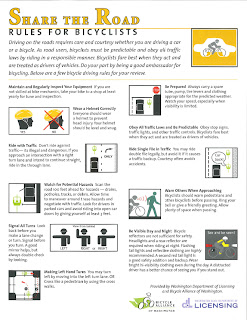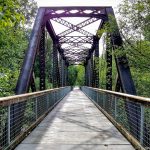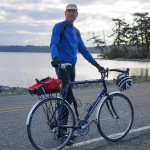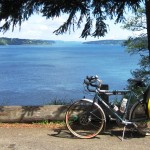Riding up 12th Avenue in Seattle one day, I came up behind a bicyclist who dodged in and out of the parking lane around parked cars. His path looked like a slalom course, zigging in towards the curb when no cars occupied the parking lane, and zagging back into the bike lane when parked cars forced him occupied the parking lane. From my perspective, the bicyclist appeared and disappeared from my path as if by magic. He was, frankly, completely unpredictable and therefore frightening.
The worst part is that this bicyclist thought he was doing the safe thing by staying as far from moving vehicles as possible, not even realizing that he risked being clocked by a turning car, an opening car door, or a faster-moving bicyclist who never saw him coming out of the parking lane.
Riding down Market Street toward downtown Kirkland, a bicyclist just ahead and to the right of me unexpectedly turned left without signaling, passing directly across my path of travel. He had assiduously eschewed a left-turn lane, favoring instead the going-straight lane that I had chosen for my straight-through path of travel. After I picked myself up off the ground, the bicyclist explained that his unexpected left turn, executed from the middle-right side of a straight lane, “avoided the bottleneck” created at the intersection where many cars choose to turn left.
The worst part is that the bicyclist thought he was doing the safe thing by staying as far from turning cars as possible, not even realizing that he was breaking the law and endangering himself and others by behaving unpredictably.

These are just two examples of choices I’ve seen cyclists make in the name of “safety” that actually endanger the bicyclist and, potentially, other road users. The two bicyclists in my vignettes didn’t realize that they needed further bicycling education, although their behavior indicated otherwise. As a previous post argued, individualized education is integral to increasing bicycling.
Even more, though, education is integral to increasing safe, predictable, legal behavior among current and future bicyclists. If we hope to achieve a truly courteous share-the-road culture in which many trips are made by bicycle, we must begin with bicyclist education. That’s why the Bicycle Alliance distributes Share the Road pamphlets (pictured) and why we have two new grants that focus specifically on education for children and adult bicyclists. We are working to create educated bicyclists who know how to use their bikes legally, safely, and predictably.
If that sounds like an exciting future to you, contact us to find out how you can help make it happen.
Edited 10/8/2010 to add: Let me give you some statistics to back up my anecdotal evidence. According to the League of American bicyclists,
- 50% of all bike crashes are falls caused by the bicyclist all by herself — she hit a rock, her front wheel got stuck in a hole, her brake cable snapped, her shoelace got wrapped around the crank arm, etc. Therefore, the individual bicyclist can prevent the vast majority of these falls by taking simple precautions like doing the ABC Quick Check before a ride and practicing good bike handling skills.
- 33% of crashes are caused by another bicyclist, a pedestrian, or an animal — something other than the bicyclist alone, but not a motor vehicle. Many of these crashes, too, can be prevented with good bike handling skills and by following laws and being predictable for pedestrians and other riders.
- The remaining 17% of crashes are motorist-bicyclist crashes, and of those, half are caused by the motorist and the other half are caused by the bicyclist. That means you can reasonably eliminate almost half of all the causes of car-bicyclist collisions, too. Here’s a breakdown of fault and cause of crash in car-bicyclist collisions.
Who is at Fault Action Causing Crash % of Crashes Bicyclist Wrong-way riding facing traffic 14% Bicyclist Left turn from right side of the road 11% Bicyclist Failure to yield from driveway* 9% Bicyclist Running a stop sign or signal 8% Bicyclist Swerving in front of a car 5% Motorist Left turn in front of bicyclist 13% Motorist Right turn in front of bicyclist 11% Motorist Running stop sign or signal 8% Motorist Opening a car door into path of bicyclist 7% Motorist Failure to yield from driveway 6% Motorist Didn’t see the bicyclist 3% * This is mostly small children.
These statistics taken from the League of American Bicyclists Smart Cycling Traffic Skills 101 Student Manual, page 22.For more information on bike safety statistics, check out the compendium of links here or here.
As you can see, by being an educated bicyclist who has good bike handling skills and rides predictably and legally, you can eliminate almost 80% of the causes of crashes. This is why bicycle education is so important. It’s not just telling people to wear helmets, but providing them with the skills and knowledge to use bikes for transportation confidently, successfully, and safely.




2 Comments
I think the point of Katie’s story is that cyclists (in general) need to take a more active role in decreasing reckless riding (deliberate or not) in order to increase drivers’ empathy to the cause of cyclist safety.
As a daily bike commuter who sees all kinds of biker ill-will generated by un-safe (often unintentional) riding habits like those she describes, I agree with her whole-heartedly.
Nice… except that helmets don't “prevent helmet injuries” and 92% of cyclist fatalities involve being struck by an automobile… which helmets are not designed or tested to deal with.
If you really want to do a campaign that seriously improves cyclist safety concentrate on education and enforcement of motor vehicle laws on the DRIVER side of the equation.
Every single car-bike incident I've ever been involved in has been the result of driver inattentiveness or downright hostility.